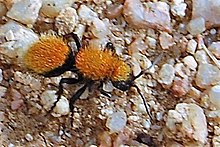You are here
Taxonomy
Mutillidae
EOL Text
Mutillidae (Velvet Ants)
Velvet Ants are hairy, brightly colored wasps, covered with orange, yellow, red, or black hairs. Their integument is exceptionally hard, and the wingless females can deliver a powerful sting. Velvet Ants invade the nests of other wasps and bees to lay their eggs (brood parasitism). Their carnivorous larvae devour the grubs of these other insects. They are uncommon visitors to flowers, but sometimes Velvet Ants seek nectar from members of the Carrot family and plants with extra-floral nectaries (e.g., Partridge Pea).
| License | http://creativecommons.org/licenses/by-nc/3.0/ |
| Rights holder/Author | Copyright © 2002-2015 by Dr. John Hilty |
| Source | http://www.illinoiswildflowers.info/flower_insects/files/wasps.htm |
Barcode of Life Data Systems (BOLD) Stats
Specimen Records:2364
Specimens with Sequences:374
Specimens with Barcodes:234
Species:310
Species With Barcodes:61
Public Records:8
Public Species:4
Public BINs:4
The Mutillidae are a family of more than 3,000 species of wasps (despite the names) whose wingless females resemble large, hairy ants. Their common name velvet ant refers to their dense pile of hair which most often is bright scarlet or orange, but may also be black, white, silver, or gold. Black and white specimens are sometimes known as panda ants due to their hair coloration resembling that of the red panda. Their bright colors serve as aposematic signals. They are known for their extremely painful stings, hence the common name cow killer or cow ant. Unlike real ants, they do not have drones, workers, and queens. However, velvet ants do exhibit haplodiploid sex determination similar to other members of the Hymenoptera, including Vespoidea.
Description[edit]
The exoskeleton of all velvet ants is unusually tough (to the point that some entomologists have reported difficulty piercing them with steel pins when attempting to mount them for display in cabinets). This characteristic allows them to successfully invade the nests of their prey and also helps them retain moisture. Like related families in the Vespoidea, males have wings but females uniformly are wingless. They exhibit extreme sexual dimorphism; the males and females are distinct enough in their morphology that associating the two sexes of a species is very challenging unless they are captured while mating. In a few species the male carries the smaller female aloft while mating, which is also seen in the related family Tiphiidae.
In mutillids, as in all Aculeata, only the female is capable of inflicting a sting because the stinger itself is a modified female organ called an ovipositor; female mutillids have unusually long and maneuverable stingers. In both sexes, a structure called a stridulitrum on the metasoma is used to produce a squeaking or chirping sound when alarmed. Both sexes of mutillids also bear hair-lined grooves on the side of the metasoma called felt lines. Only one other vespoid family, the Bradynobaenidae, has felt lines, but the females have a distinct pronotum and an elongated ant-like petiole.
Behavior[edit]
Mature mutillids feed on nectar. Although some species are strictly nocturnal, females are often active during the day. Females of Tricholabiodes thisbe are sometimes active up to two hours before sunset. Guido Nonveiller (1963) hypothesized the Mutillidae are generally stenothermic and thermophilic; they may not avoid light, but rather are active during temperatures which usually occur only after sunset.
Life cycle[edit]
Male mutillidae fly in search of females, and after mating the female then enters an insect nest, typically a ground-nesting bee or wasp burrow, and deposits one egg near each larva or pupa. The mutillid larvae then develop as idiobiont ectoparasitoids, eventually killing their immobile larval/pupal hosts within a week or two.
Range[edit]
The 3,000-5,000 species of Mutillidae occur worldwide, mainly in the dry tropics. They are especially common, however, in desert and sandy areas, with most of the over 400 North American species found in the southwestern United States and adjacent parts of Mexico, with others found in generally sandy regions throughout the United States and Canada.
References[edit]
- A. S. Lelej Catalogue of the Mutillidae (Hymenoptera) of the Palaearctic Region (pdf)
- J.H. Hunt. 1999. Trait mapping and salience in the evolution of eusocial vespid wasps. Evolution 53: 225-237 (pdf)
- Lorus J. Milne, National Audubon Society Field Guide to North American Insects and Spiders (Audubon Society Field Guide) (Turtleback)(1980) Knopf. ISBN 0-394-50763-0.
- Nonveiller, G. Catalogue of the Mutillidae, Myrmosidae and Bradynobaenidae of the Neotropical Region including Mexico (Insecta: Hymenoptera). SPB Academic Publishing bv, the Netherlands, pp. 1–150.
| License | http://creativecommons.org/licenses/by-sa/3.0/ |
| Rights holder/Author | Wikipedia |
| Source | http://en.wikipedia.org/w/index.php?title=Mutillidae&oldid=653934018 |
http://entnemdept.ufl.edu/creatures/misc/wasps/mutillidae.htm
Founded in 1996 by Thomas Fasulo, Featured Creatures provides in-depth profiles of insects, nematodes, arachnids and other organisms.
The Featured Creatures site is a cooperative venture of the University of Florida's Entomology and Nematology Department and the Florida Department of Agriculture and Consumer Services' Division of Plant Industry.
Visit Featured Creatures at http://entnemdept.ifas.ufl.edu/creatures/
| License | http://creativecommons.org/licenses/by-nc-sa/3.0/ |
| Rights holder/Author | Featured Creatures |
| Source | http://entnemdept.ufl.edu/creatures/misc/wasps/mutillidae.htm |



